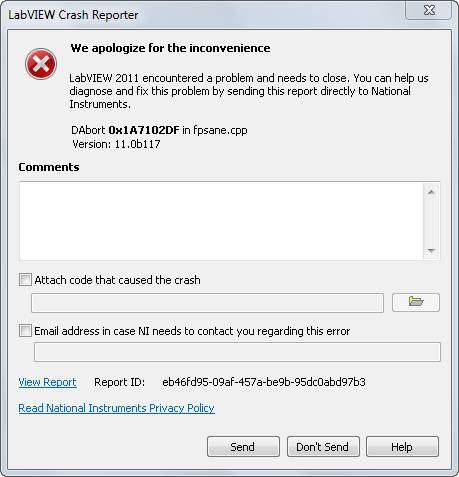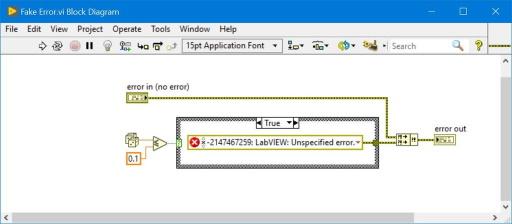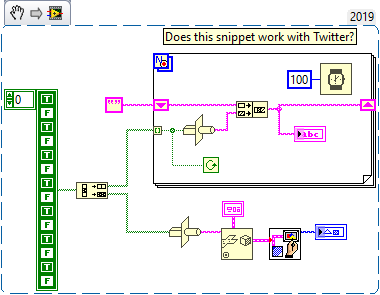-
Posts
35 -
Joined
-
Days Won
8
Dataflow_G last won the day on March 15 2023
Dataflow_G had the most liked content!
Contact Methods
- Personal Website
- Company Website
-
Twitter Name
@Dataflow_G
LabVIEW Information
-
Version
LabVIEW 2018
-
Since
2017
Recent Profile Visitors
The recent visitors block is disabled and is not being shown to other users.
Dataflow_G's Achievements
-

Seeing a Malleable VI (.vim) implementation
Dataflow_G replied to GregSands's topic in LabVIEW General
I posted an idea on the idea exchange on viewing a vim's instance VI, but it looks like that ability was added to LabVIEW at some point (by AQ?). The labview.ini token allowOpenFPOfInstanceVIs changes the behavior of the Convert Instance VI to Standard VI option to instead open the instance VI. I'd been using the convert to standard / ctrl+z method but it's very easy to forget the ctrl+z bit. This token is much more useful. -

Please can anyone help me optimising this code
Dataflow_G replied to Neil Pate's topic in LabVIEW General
Is working with the image data as a contiguous 1D array, rather than a 2D array an option? I wrote a small image library for LabVIEW (G-Image), and found working with 1D arrays of image data consistently faster than 2D arrays. Attached is a quick version which performs the per item + row methods using a 1D array, and both are quicker than their 2D counterparts. Raster 1D 2015.zip -
Here's a couple more promotional videos recently unearthed. NIWeek 99 Highlights: NIWeek 2000 promotional video, with invitation by Dr. T:
-

Running zmq package on Linux Ubuntu20 (c library build)
Dataflow_G replied to Łukasz's topic in Linux
Thanks for confirming its working 👍 -

Running zmq package on Linux Ubuntu20 (c library build)
Dataflow_G replied to Łukasz's topic in Linux
The problem looks to be zmq_labview.c is calling functions in the zeromq library which are specified as draft functions, and are disabled in stable release versions. These functions are listed in the compilation output as implicitly declared, and when configuring the CLFN in LabVIEW, it throws a warning it can't find them. This is likely the cause of error 13. If you check zmq.h, it has the following comment: /******************************************************************************/ /* These functions are DRAFT and disabled in stable releases, and subject to */ /* change at ANY time until declared stable. */ /******************************************************************************/ #ifdef ZMQ_BUILD_DRAFT_API ... /* DRAFT Socket methods. */ ZMQ_EXPORT int zmq_join (void *s, const char *group); ZMQ_EXPORT int zmq_leave (void *s, const char *group); ... #endif If -D ZMQ_BUILD_DRAFT_API is added to the compile flags, the implicit declaration warnings are no longer present. But you still have the problem that the stable release of zeromq doesn't have these functions available. So you'll either need to find and install a draft release (these don't appear to be pre-built for Ubuntu), compile it yourself with draft APIs enabled (possibly using -DENABLE_DRAFTS=ON), or replace the functions from the draft spec in zmq_labview.c. -
There's a couple of videos on NI's youtube covering new hardware and software products. They're both heavy on marketing and light on details, but put things like TestScale into context. Hardware: https://www.youtube.com/watch?v=-8VGCjzJjWk Software: https://www.youtube.com/watch?v=hH8VFB9jtzM Edit: That ShireyStudios youtube account also uploaded some new NI Connect videos in the past couple of days. Did they manage video recording of the event? Kinda surprised the vids aren't on NI's main account.
-

Malleable Buffer (seeing what VIMs can do)
Dataflow_G replied to drjdpowell's topic in Code In-Development
I can't speak for the buffer library, but I've observed this behavior many times with malleable VIs in my own code. One thing (bug?) I've noticed (and reported on the dark side) is that nested type specialization structures within a vim can lead to broken wires. This is generally as a result of an assert vim inside a type specialization structure inside a vim. The callers wires are either visibly broken but otherwise runnable, or just broken even though the input types are supported. The LabVIEW 2021 SP1 bug fixes mention a fix (bug ID: 1596011) for vims and erroneously broken wires, but I've not tried it out yet. I really hope that's the end of the broken wire quirks with malleable VIs, as they're a really great feature. -
Yeah, LabVIEW's Linux audio support hasn't been touched in years. It's built on OSS, which was superseded by ALSA on Arch Linux in 2002. None of the Linux distros LabVIEW Community Edition supports ship with OSS support, but I believe it can be added via an ALSA-OSS translation layer. Also worth noting LabVIEW for Linux can only write 16-bit WAV files, and not IEEE float WAVs (which can be written in LabVIEW for Windows). If you want to play/capture/record audio under Linux, I'm working on an open source, cross-platform audio library for LabVIEW called G-Audio. It's been tested under Arch Linux and CentOS, and supports playback and capture on ALSA and PulseAudio backends, supports writing PCM / IEEE WAVs, and can read WAV, MP3, FLAC, and Ogg Vorbis files.
-

Something I obviously don't understand about a Picture Control
Dataflow_G replied to Neil Pate's topic in User Interface
Sounds like a cool project, especially with a real 6502 thrown in. I remember seeing an open source Apple II emulator written in LabVIEW: https://sourceforge.net/projects/labviewapple2/ Not sure how well it runs, but might be interesting to compare notes. -

Something I obviously don't understand about a Picture Control
Dataflow_G replied to Neil Pate's topic in User Interface
The diagonals need to be in the form: [0,1] [1,0] or [1,0] [0,1] The 'M' only has a single pixel, or three pixels in a 2x2 grid area, so the anti-aliasing isn't applied. Not sure why it has been implemented this way. -

Something I obviously don't understand about a Picture Control
Dataflow_G replied to Neil Pate's topic in User Interface
It looks like the picture control is trying to be smart, and anti-aliases diagonal pixels of the exact same color. If the colors differ by a single bit, the anti-aliasing doesn't occur: The picture control also does some kind of pixel hinting - try resize the picture control when the zoom factor is high. You can see it snaps the pixels to some hidden grid in an effort to align it to the picture control bounds. I don't see any properties for disabling the anti-aliasing or the hinting. Perhaps a 2D array of color boxes could be used? With the classic controls there's no gaps between elements: -

Graphical programming for the Nintendo Switch - Game Builder Garage
Dataflow_G replied to Dataflow_G's topic in LAVA Lounge
-
To add to the list of potential red flags: Windows Registry Access VIs VI Scripting calls (deleting or subtly modifying existing project code) Large VI file sizes / large constants (malicious VIs stored as byte arrays, so avoiding VI Analyzer's checks) Bugs known to crash LabVIEW Shortened links in VI help Non-standard block diagram colors (hiding a subVI on an identically colored BD) Obfuscated code (strings masquerading as boolean arrays, numbers with hidden precision, etc): Very small subVI icons (think a VI disguised as an error wire, as seen on reddit😞 In reality flagging a package based on any of the previously mentioned criteria will be almost exclusively false positives. Perhaps providing a list of function types a library uses would better help the developer assess the library, similar to the app permissions shown when downloading an app on iOS / Android. So a library may use Network, Scripting, and File System. As LogMAN said, it's ultimately up to the developer to take responsibility for the code they use. obfuscated_LV2014.vi
-

What do you think of the new NI logo and marketing push?
Dataflow_G replied to Michael Aivaliotis's topic in LAVA Lounge
Here's some more rebrand info I found by one of the design companies behind NI's rebrand, including a mock-up of a green PXI with an interesting font choice (I'm pretty sure that's a Q).










